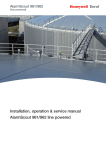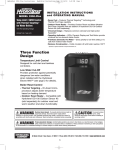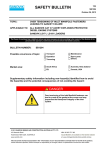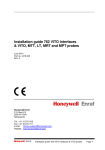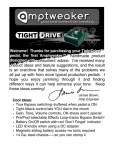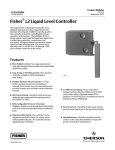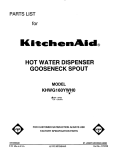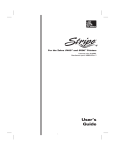Download Installation, operation & service manual AlarmScout A15
Transcript
AlarmScout A15 Installation, operation & service manual AlarmScout A15 UNPACKING Top mounting displacer units are shipped from the factory with the displacer and cable assembly removed from the head assembly and packed separately in the same container. If reshipping to another location, displacer assembly must again be removed from the control to prevent damage. Unpack the instrument carefully. Make sure all components have been removed from the foam protection. Inspect all components for damage. Report any concealed damage to the carrier within 24 hours. Check the contents of the carton/crates against the packing slip and report any discrepancies to Honeywell Enraf. Check the nameplate model number to be sure it agrees with the packing slip and purchase order. Check and record the serial number for future reference when ordering parts. 0038 0344 HANDLING Nameplate: - part number - serial n° These units are in compliance with: 1. Directive 94/9/EC for equipment or protective system intended for use in potentially explosive atmospheres. EC-type examination certificate number ISSeP09ATEX024X - flameproof enclosure. 2. The PED Directive 97/23/EC (pressure equipment directive). Safety accessories per category IV module H1. The threaded connection link and stem protruding from the head assembly are extremely fragile. DO NOT handle or place control in a position so that any amount of force is placed on the stem. Proper operation of the control requires that the stem is not damaged or bent. Displacer spring and stem are fragile. DO NOT drop displacers into tank. Hand feed cable into position to avoid bending stem. MOUNTING Adjust the displacer on the displacer cable for the desired switch actuating level (instruction tag attached to cable). Screw displacer cable fitting to threaded connection link protruding from the underside of control. Floating roof High level Be sure there are no tubes, rods, or other obstacles in the tank or vessel to interfere with the operation of the displacer. No guides into the tank are necessary unless liquid turbulence is excessive, in which case a "guided pipe" or tube should be at least 25 mm larger than the displacer diameter, open at the bottom end and with several vent holes located above the maximum high level of the liquid. Check installation of pipe or tube to be certain it is plumb. CAUTION: Before attaching the control to tank or vessel, using a level, check to see that tank mounting flange is within 3° of horizontal in all directions. Proper operation of the control depends on the switch housing being plumb. For floating roof top applications, the displacer switch may be mounted via flange or threaded mounting on a bracket, catwalk, etc. or through an opening in an outer dome roof. Ensure that there are no obstacles to interfere with the operation of the displacers or weights and that there is a level surface on the roof beneath the displacer/weight. CAUTION: Operation of all buoyancy type level devices should be done in such a way as to minimize the action of dynamic forces on the float or displacer sensing element. Good practice for reducing the likelihood of damage to the control is to equalize pressure across the device slowly. 2 Instruction & installation manual AlarmScout A15 Part No.: 4417903_Rev.0 WIRING CAUTION: Level controls are shipped from the factory with the enclosing tube tightened and the middle set screw, on the housing base, locked to the enclosing tube. Failure to loosen the set screw prior to repositioning the cable entry may cause the enclosing tube to loosen, resulting in the possible leakage of the process liquid or vapor. Cover locking screw (ATEX flameproof only) Screw Screw Set Screw CAUTION: DO NOT attempt to unscrew the cover of ATEX flameproof housings before loosening the locking screw. ALWAYS retighten the locking screw after replacing the cover. The switch housing is designed to provide 360° positioning of cable entry by loosening the set screw(s) located under the housing base. On high temperature applications [above 120 °C (250 °F)] high temperature wire should be used between control and first junction box located in a cooler area. Supply wires (conductors) are brought into the switch housing, wrapped around the enclosing tube under the baffle plate and then brought up to the proper terminals. Excess wire should be positioned so as not to interfere with switch mechanism or housing cover. Some controls are furnished with an explosion proof (cast) switch housing or a vapor tight (gasketed) type. These housings are used in hazardous locations or when liquid temperature is so low that excessive condensation and frosting of switch parts is likely. After wiring connections have been completed, explosion proof housings must be "sealed" at the cable entry with suitable compound or "dope" to prevent entrance of air. Check cover to base fit on explosion proof and vapor tight housings to be certain gasketed joint is tight. A positive seal is necessary to prevent infiltration of moisture laden air or corrosive gases into switch housing. Connect power supply to control and test switch action by varying liquid level. If switch mechanism fails to function, check vertical alignment of control. Diagrams of internal electrical circuits SPDT DPDT Switch identification Line Load Outside circuit A B Close on low level 1 4 Common 2 5 Close on high level 3 6 Load NOTE: 1. Rising level closes contacts 5 & 6. 2. Falling level closes contacts 4 & 5. Part No.: 4417903_Rev.0 Internal circuit (left switch) Internal circuit 4 1 5 2 6 3 Close on high level Load Internal circuit (right switch) Load Close on high level Common Common Close on low level Load Load Close on low level NOTE: 1. Double pole action is obtained by simultaneous operation of the right and left side single pole switches. 2. Rising level closes contacts 5 & 6 and 2 & 3. 3. Falling level closes contacts 4 & 5 and 1 & 2. Line AlarmScout A15 Line Instruction & installation manual 3 SET UP AND FUNCTIONS Operating cycle 4 1 2 3 2 5 3 1 1 2 3 4 2 5 A spring is loaded with a weighted displacer which is heavier than the liquid. Immersion of the displacers caused by rising liquid level imparts buoyancy forces on the displacer allowing the spring to compress. The attraction sleeve attached to the spring, moves upward into the field of a permanent magnet . The movement of the magnet toward the sleeve causes the switch to actuate. A non-magnetic barrier tube provides a static pressure boundary between the switch mechanism and the displacer assembly. As the liquid level falls, the displacer lowers, causing the spring to extend, and moving the attraction sleeve out of the magnetic field of the switch mechanism. This allows the switch to again change position and to break or make. 3 1 Switch position on rising level Floating roof detection Switch position on falling level Operating cycle – Proof-er control option The purpose of the Proof-er is to check the operation of a displacer control without having to raise the level in the tank. This is accomplished by pulling downward on the Proof-er cable. This causes the spring loaded lever arm to lift the switch actuator, simulating a high or high–high level condition. When the cable is released, the Proof-er returns the actuator to its original position resuming normal operation. The spring is loaded with a displacer weight suspended from a stainless steel cable. As the floating roof rises, the weight is lifted by the roof allowing the spring to compress, the attraction sleeve to move upward into the field of the switch magnet and the switch to actuate. As the roof lowers, the weight again hangs free causing the spring to extend, the sleeve to move downward and the switch to reset. The displacers are usually fabricated from ductile metals, such as brass, to prevent sparking when the displacer makes contact with the roof. MAINTENANCE Preventive maintenance If the following sections on "What to do" and "what to avoid" are observed, your level control will operate reliably. WHAT TO DO 1. Keep control clean Be sure the switch housing cover is always in place on the control. This cover is designed to keep dust and dirt from interfering with switch mechanism operation. In addition, it protects against damaging moisture and acts as a safety feature by keeping bare wires and terminals from being exposed. Should the housing cover become damaged or misplaced, order a replacement immediately. 2. Inspect switch mechanisms, terminals and connections regularly – Dry contacts switches should be inspected for excessive wear on actuating lever or misalignment of adjustment screw at point of contact between screw and lever. Such conditions can cause false switch actuating levels. Adjust switch mechanism to compensate (if possible) or replace switch. – DO NOT operate your control with defective or maladusted switch mechanisms. – Level controls may sometimes be exposed to excessive heat or moisture. Under such conditions, insulation on electrical wires may become brittle, eventually breaking or peeling away. The resulting "bare" wires can cause short circuits. Check wiring carefully and replace at first sign of brittle insulation. – Vibration may sometimes cause terminal screws to work loose. Check all terminal connections to be certain that screws are tight. 4 Instruction & installation manual WHAT TO AVOID 1. NEVER leave switch housing cover of the control longer than necessary to make routine inspections. 2. NEVER use lubricants on pivots of switch mechanisms. A sufficient amount of lubricant has been applied at the factory to insure a lifetime of service. Further oiling is unnecessary and will only tend to attract dust and dirt which can interfere with mechanism operation. 3. NEVER attempt to make adjustments or replace switches without reading instructions carefully. Certain adjustments provided for in level controls should not be attempted in the field. When in doubt, consult the factory or your local representative. 4. NEVER attempt to readjust magnetic attraction sleeves which are factory set. Tampering may cause failure of control while in service even though manual operation actuates switches. AlarmScout A15 Part No.: 4417903_Rev.0 MAINTENANCE Troubleshooting a. Disconnect wiring from supply side of switch mechanism(s) and remove electrical conduit or operating medium line connections to switch housing. Usually the first indication of improper operation is failure of the controlled equipment to function, i.e, pump will not start (or stop), signal lamps fail to light, etc. When these symptoms occur, whether at time of installation or during routine service thereafter, check the following potential external causes first. – – – – – Fuses may be blown. Reset button(s) may need resetting. Power switch may be open. Controlled equipment may be faulty. Wiring leading to control may be defective. If a thorough inspection of these possible conditions fails to locate the trouble, proceed next to a check of the control's switch mechanism. Check switch mechanism 1. Disconnect power to the level control. 2. Remove switch housing cover. 3. Disconnect power wiring from switch assembly. 4. Swing magnet assembly in and out by hand to check carefully for any sign of binding. Assembly should require minimal force to move it through its full swing. 5. If binding exists, magnet may be rubbing enclosing tube. If magnet is rubbing, loosen magnet clamp screw and shift magnet position. Retighten magnet clamp screw. 6. If switch magnet assembly swings freely and mechanism still fails to actuate, check installation of control to be certain it is within the specified three degrees of vertical. (Use spirit level on side of enclosing tube in two places, 90° apart.) 7. Check switch continuity with ohmmeter. NOTE: As a matter of good practice, spare switches should be kept on hand at all times. If switch mechanism is operating satisfactorily, proceed to check sensing unit. Test controlʼs performance 1. Reconnect power supply and carefully actuate switch mechanism manually, using a non-conductive tool on electrical switch mechanism, to dertermine whether controlled equipment will operate. b. Relieve pressure from tank or vessel and allow unit to cool. c. Remove switch housing assembly by loosening set screws located at the bottom of the housing base. 4. With switch housing assembly removed, inspect attraction sleeve and inside of enclosing tube for excessive corrosion or solids buildup which could restrict movement, preventing sleeve from reaching field of switch magnet. 5. Inspect displacer stem and spring assembly to assure it is not damaged. If stem or spring is bent or otherwise damaged, movement of the attraction sleeve inside the e-tube will be restricted, preventing proper function of the control. 6. If trouble is still not located, proceed to remove the entire sensing unit from the tank or vessel by unbolting head flange or unscrewing mounting bushing. Inspect displacer assembly and all internal parts for any signs of damage. Check assembly for binding by supporting head flange or mounting bushing over the edge of a bench and move displacer assembly by hand. NOTE: When in doubt about the condition or performance of a control, contact the factory or consult your local representative. Proof-er If the Proof-er is not functioning properly, listed below are potential problems and corrective action. 1. Proof-er does not return to the down position after it is activated. CAUSE Defective return spring. Buildup between the shaft and housing restricting movement. Handle stops are not adjusted properly. CAUTION: With electrical power on, care should be taken to avoid contact with switch leads and connections at terminal block. 2. If controlled equipment responds to manual actuation test, trouble may be located in level sensing portion of the control (displacers, spring, stem, and magnetic attracting sleeve). Clean Proof-er to remove buildup. Adjust handle stop screws in or out to allow the handle to move to the proper position. 2. Switch will not trip when Proof-er is activated. NOTE: Check first to be certain liquid is entering tank or vessel. A valve may be closed or pipe line plugged. 3. With liquid in tank or vessel, proceed to check level sensing action by removing switch housing assembly. CAUTION: Be certain that electrical circuit(s) through control is deactivated. Part No.: 4417903_Rev.0 REMEDY Replace spring. AlarmScout A15 CAUSE The switch mechanism is defective and not the Proof-er. Handle stops are not adjusted properly. REMEDY Check switch mechanism. Adjust handle stop screws in or out to allow the handle to move to the proper position. Instruction & installation manual 5 SPARE PARTS CAUTION: DO NOT attempt to unscrew the cover of ATEX flameproof housings before loosening the locking screw. ALWAYS retighten the locking screw after replacing the cover. Replacing switch assembly CAUTION: Before attempting to remove a switch mechanism, be certain that electrical circuit(s) through control is deactivated. 1. Disconnect wiring from supply side of terminal block on switch mechanism. Note and record lead wire terminal locations. 2. Loosen screw in split mounting clamp until mechanism slides freely on enclosing tube. 3. Remove small round head screw securing lower switch mechanism to baffle plate. Mounting screw 4. Slide switch mechanism off of enclosing tube. If mechanism is to be reused, ensure that it is placed on a clean surface, free of metallic particles that may be attracted to the switch magnet. 5. Loosen mounting screw so that switch frame will fit over e-tube. Install switch mechanism by sliding it over the enclosing tube. Slide mechanism down until the bottom of the frame and terminal block are resting on the baffle plate. The baffle plate should be resting on the hub of the housing base. Baffle plate screw Baffle plate screw 6 Instruction & installation manual 6. Install and tighten baffle plate screw so that the switch mechanism may not be separated from the baffle plate. Tighten the mechanism mounting screw so that the mechanism is firmly clamped to the enclosing tube. 7. Swing magnet assembly in and out by hand, checking carefully for any signs of binding. 8. Reattached supply-side wiring to the terminal block and check switch function by varying liquid level in the vessel. AlarmScout A15 Part No.: 4417903_Rev.0 SPARE PARTS Spare parts Partn°: Digit in partn°: 1 2 3 4 5 6 7 8 4 5 9 10 11 1 Lockwasher ground screw Baffle plate 2 Locking screw for ATEX flameproof housing Serial n°: See nameplate, always provide complete partn° and serial n° when ordering spares. Housing base External grounding screw for ATEX housing 3 Set screw 4 Set screw 7 6 6 7 6 6 6 8 8 (1) Housing cover (2) "O"-ring (3) "O"-ring (4) Enclosing tube (6) E-tube gasket (7) Proof-er cable kit (8) Displacer + cable kit Part No.: 4417903_Rev.0 Spare part consult factory 012-2201-253 012-2201-116 consult factory 012-1301-002 consult factory consult factory AlarmScout A15 Digit 9 B C U X (5) Switch assembly Digit 10 + 11 Spare part H9 or KQ 089-7401-104 J9 or NQ 089-7401-122 H9 or KQ 089-7401-110 J9 or NQ 089-7401-125 H9 or KQ 189-9109-901 J9 or NQ 189-9111-901 H9 or KQ 089-7412-004 J9 or NQ 089-7412-005 Instruction & installation manual 7 Fo r M o r e I n f or m a t i on To learn more about Honeywell Enraf’s solutions, contact your Honeywell Enraf account manager or visit www.honeywellenraf.com. A m er i c as Honeywell Enraf Americas, Inc. 2000 Northfield Ct. Roswell, GA 30076 USA Phone: +1 770 475 1900 Email: [email protected] Eur ope , M iddle East and Af r ica Honeywell Enraf Delftechpark 39 2628 XJ Delft The Netherlands Phone: +31 (0)15 2701 100 Email: [email protected] Asi a Pac ifi fic c Honeywell Pte Ltd. 17 Changi Business Park Central 1 Singapore 486073 Phone: +65 6355 2828 Email: [email protected] 4417903_Rev.0 APRIL 2012 © 2011 Honeywell International Inc.








